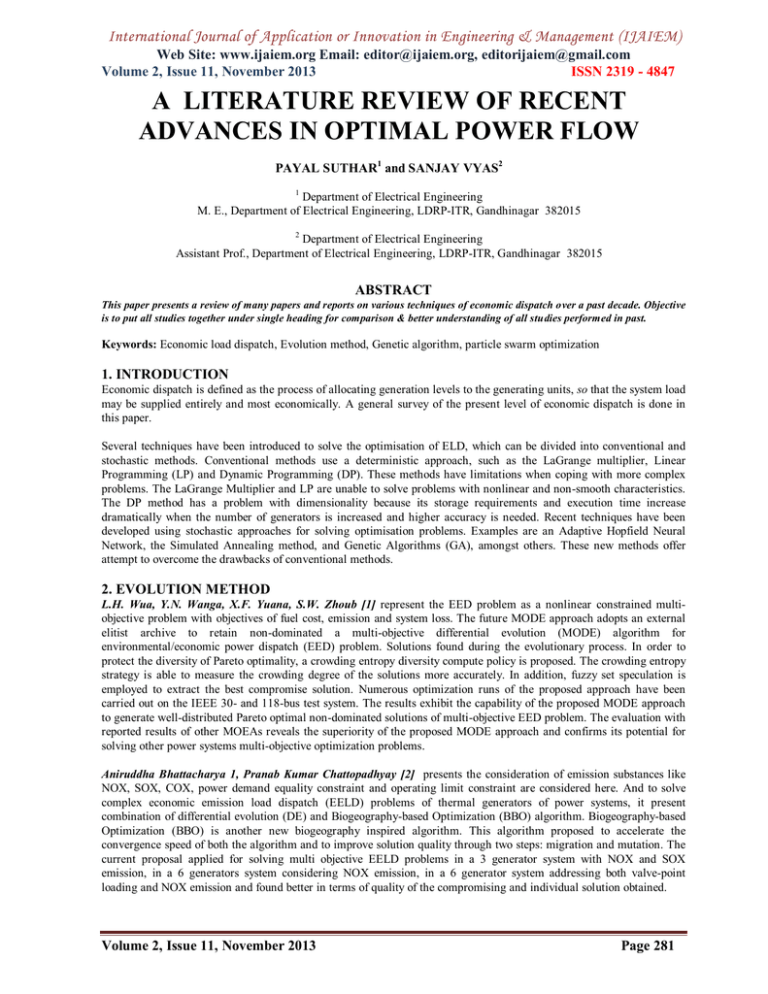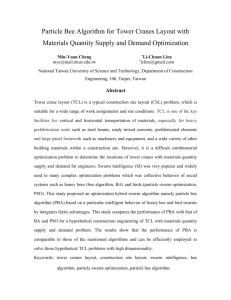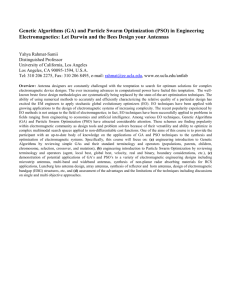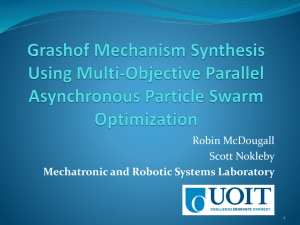A LITERATURE REVIEW OF RECENT ADVANCES IN OPTIMAL POWER FLOW
advertisement

International Journal of Application or Innovation in Engineering & Management (IJAIEM) Web Site: www.ijaiem.org Email: editor@ijaiem.org, editorijaiem@gmail.com Volume 2, Issue 11, November 2013 ISSN 2319 - 4847 A LITERATURE REVIEW OF RECENT ADVANCES IN OPTIMAL POWER FLOW PAYAL SUTHAR1 and SANJAY VYAS2 1 Department of Electrical Engineering M. E., Department of Electrical Engineering, LDRP-ITR, Gandhinagar 382015 2 Department of Electrical Engineering Assistant Prof., Department of Electrical Engineering, LDRP-ITR, Gandhinagar 382015 ABSTRACT This paper presents a review of many papers and reports on various techniques of economic dispatch over a past decade. Objective is to put all studies together under single heading for comparison & better understanding of all studies performed in past. Keywords: Economic load dispatch, Evolution method, Genetic algorithm, particle swarm optimization 1. INTRODUCTION Economic dispatch is defined as the process of allocating generation levels to the generating units, so that the system load may be supplied entirely and most economically. A general survey of the present level of economic dispatch is done in this paper. Several techniques have been introduced to solve the optimisation of ELD, which can be divided into conventional and stochastic methods. Conventional methods use a deterministic approach, such as the LaGrange multiplier, Linear Programming (LP) and Dynamic Programming (DP). These methods have limitations when coping with more complex problems. The LaGrange Multiplier and LP are unable to solve problems with nonlinear and non-smooth characteristics. The DP method has a problem with dimensionality because its storage requirements and execution time increase dramatically when the number of generators is increased and higher accuracy is needed. Recent techniques have been developed using stochastic approaches for solving optimisation problems. Examples are an Adaptive Hopfield Neural Network, the Simulated Annealing method, and Genetic Algorithms (GA), amongst others. These new methods offer attempt to overcome the drawbacks of conventional methods. 2. EVOLUTION METHOD L.H. Wua, Y.N. Wanga, X.F. Yuana, S.W. Zhoub [1] represent the EED problem as a nonlinear constrained multiobjective problem with objectives of fuel cost, emission and system loss. The future MODE approach adopts an external elitist archive to retain non-dominated a multi-objective differential evolution (MODE) algorithm for environmental/economic power dispatch (EED) problem. Solutions found during the evolutionary process. In order to protect the diversity of Pareto optimality, a crowding entropy diversity compute policy is proposed. The crowding entropy strategy is able to measure the crowding degree of the solutions more accurately. In addition, fuzzy set speculation is employed to extract the best compromise solution. Numerous optimization runs of the proposed approach have been carried out on the IEEE 30- and 118-bus test system. The results exhibit the capability of the proposed MODE approach to generate well-distributed Pareto optimal non-dominated solutions of multi-objective EED problem. The evaluation with reported results of other MOEAs reveals the superiority of the proposed MODE approach and confirms its potential for solving other power systems multi-objective optimization problems. Aniruddha Bhattacharya 1, Pranab Kumar Chattopadhyay [2] presents the consideration of emission substances like NOX, SOX, COX, power demand equality constraint and operating limit constraint are considered here. And to solve complex economic emission load dispatch (EELD) problems of thermal generators of power systems, it present combination of differential evolution (DE) and Biogeography-based Optimization (BBO) algorithm. Biogeography-based Optimization (BBO) is another new biogeography inspired algorithm. This algorithm proposed to accelerate the convergence speed of both the algorithm and to improve solution quality through two steps: migration and mutation. The current proposal applied for solving multi objective EELD problems in a 3 generator system with NOX and SOX emission, in a 6 generators system considering NOX emission, in a 6 generator system addressing both valve-point loading and NOX emission and found better in terms of quality of the compromising and individual solution obtained. Volume 2, Issue 11, November 2013 Page 281 International Journal of Application or Innovation in Engineering & Management (IJAIEM) Web Site: www.ijaiem.org Email: editor@ijaiem.org, editorijaiem@gmail.com Volume 2, Issue 11, November 2013 ISSN 2319 - 4847 Hong-Tzer Yang Member, IEEE Pai-Chum Yang Ching-Lien Huang Member, IEEE [3] develops an algorithm based on evolutionary programming for general economic dispatch (ED) algorithm for units with non-smooth fuel cost functions. the new develop algorithm has capacity of determining the global or near global optimal dispatch solutions. Practical application of the new developed algorithm is verified on the Taiwan power (Taipower) system And results show that the proposed EP based ED algorithm can give accurate dispatch solutions within reasonable time for any type of fuel cost functions. M.I. Mosaad, M.M. El Metwally, A.A. El Emary and F.M. El Bendary [4] This paper aims to solve On-Line Optimal Power Flow (ON-OPF) to minimize fuel cost using Evolutionary Programming Techniques. The key of that optimization problem is based on using the Particle Swarm Optimization (PSO) technique for each loading condition with minimum fuel cost. All earlier obtained grades are used as a database for training an Artificial Neural Network (ANN) to obtain an on line solution (decision) to control output power of each generating unit at different loading conditions while satisfying minimum fuel cost. 2.1 GENETICAL ALGORITHM Tarek BOUKTIRa, Linda SLIMANIa, M. BELKACEMIb [5] presents a simple genetic algorithm solution to solve optimal power flow problem of large distribution systems . The aim is to minimize the fuel cost and keep the power outputs of generators, bus voltages, shunt capacitors/reactors and transformers tap-setting in their secure limits. We can be reduced CPU times by decomposing the optimization constraints to active constraints manipulated directly by the genetic algorithm, and inert constraints maintained in their soft limits using a conventional constraint load flow. The IEEE 30-bus system has been studied to show the effectiveness of the algorithm. Mirko Todorovski and Dragoslav Rajiˇcic´, Senior Member, IEEE [6] give an idea to use voltage angles at generator buses as a control variables to get load buses voltage with less calculation. This approach in solving the optimal power flow problem by genetic algorithms may be ineffective if starting values of voltage angles are choose randomly. To solve these difficulties, a procedure for selection of an initial set of complex voltages at generator- buses is proposed in this paper. With this procedure, one can start the optimization process (i.e., genetic algorithm) with a set of control variables, causing few or no violation of constraints. They are competitive, with computational time drastically reduced. Mohammed LAOUER, Ahmed ALLALI, Abdelkader CHAKE, Kaddour HACHEMI [7] state the calculation of optimal power flow for active and reactive power using genetic Algorithm which simplifies more difficulties of the given problem. In this case, the mathematical aspect is based on the analogy of the physical and biological processes and it reduces the complexity, which is usually encountered, for the resolution of the optimisation problems.. This approach is more effective and powerful and The combination of the decoupled method and GAs calculation algorithm of the optimal power distribution. Wei Yan, Fang Liu, C. Y. Chung, Member, IEEE, and K. P. Wong, Fellow, IEEEI [8] is proposed, a novel hybrid method for the optimal reactive power flow (ORPF) problem. This method can be mainly divided into two parts. The first part is to solve the ORPF with the IPM by relaxing the discrete variables. The second part is to crumble the original ORPF into two sub-problems: continuous optimization which is solve by IPM with discrete variables being constant and discrete optimization which is solve by GA with continuous variables being fixed. The optimal solution can be obtained by solving the two sub-problems alternately. A dynamic adjustment policy is also proposed to make the GA and the IPM to complement each other and to enhance the efficiency of the hybrid proposed method. 2.2 PARTICLE SWARM OPTIMIZATION D.N. Jeyakumar b, T. Jayabarathi a, T. Raghunathan [9] describes a successful implementation of the particle swarm optimisation (PSO) algorithm to solve various types of economic dispatch (ED) problems in power systems such as, multiarea ED with tie line restrictions, ED with multiple fuel options, mutual environmental economic dispatch, and the ED of generators with proscribed operating zones. The results obtained using both the PSO method and the classical evolutionary programming (CEP) approach show that the proposed PSO based ED algorithm can provide comparable dispatch solutions with reduced computation time for all types of ED problems. Zhang Zhisheng [10] state that Quantum-behaved particle swarm optimization algorithm is firstly used in economic load dispatch of power system and is the integration of particle swarm optimization algorithm and quantum computing theory. The superposition characteristic and possibility representation of quantum methodology are combined into particle swarm optimization algorithm. The algorithm is simulated by two cases, which validates it can efficiently solve economic load Volume 2, Issue 11, November 2013 Page 282 International Journal of Application or Innovation in Engineering & Management (IJAIEM) Web Site: www.ijaiem.org Email: editor@ijaiem.org, editorijaiem@gmail.com Volume 2, Issue 11, November 2013 ISSN 2319 - 4847 dispatch problem. Though performance assessment it is obvious the solution is superior to that of improved particle swarm optimization algorithm and other optimization algorithms. Ranjit Roy a, S.P. Ghoshal b [11] studied the comparative effectiveness of GA, Improved fast EP (IFEP) and various particle swarm optimizations (PSO) reported in the literature and a novel particle swarm algorithm namely CRAZYPSO for such multi-objective optimization in two test cases. The authors have The first test case deals with some well-known Benchmark functions and then the second case deals with a general power system having 40 thermal generating units with non-monotonically increasing cost functions with valve point loadings and other constraints. The generators are interconnected through lossy transmission lines. The proposed method out performs and provides true global optimal solutions as compared to other existing techniques for economic load dispatch. Ying-ping Chen, Pei Jiang [12] proposed a statistical interpretation of particle swarm optimization in order to capture the stochastic behaviour of the entire swarm. we find the effect of particle interaction by focusing on the social-only model and derive the upper and lower bounds of the expected particle norm. Furthermore, the sufficient and necessary condition for the swarm to converge is derived to demonstrate the PSO convergence caused by the effect of particle interaction. 2.3 OTHER METHOD Jiejin Cai a,b, Qiong Li c, Lixiang Li d, Haipeng Peng d, Yixian Yang d [13] developed a fuzzy adaptive chaotic ant swarm optimization (FCASO) algorithm which introduces a fuzzy system to dynamically tune the characteristic parameters wd and ri of chaotic swarm optimization (CASO). This method was applied to two cases of power systems. The simulation results reveal the applicability and effectiveness of the proposed algorithm to the practical ED problem. Rajesh Kumar a, Abhinav Sadu a, Rudesh Kumar a, S.K. Panda b [14] proposed algorithm is an integration of the deterministic search, the multi-agent system (MAS) environment and the bee decision-making process both equality and inequality constraints. The hybridization makes MODBC to obtain a unique and fast solution and hence generate a better pareto front for multi-objective problems. The above multi-objective evolutionary algorithms have been applied to the standard IEEE 30 bus six generator test system and Results results show the robustness and accuracy of the proposed algorithm over the traditional methods and its other multi-objective evolutionary algorithm (MOEA) counterparts. Miodrag DjukanoviC Milan CaloviC Borka Milogevik Dejan J. Sobajic[15] proposed economic dispatch uses an artificial neural network (A") for generation or penalty factors, depending on the input generator powers and identified system load change. The approach can take into account the operational requirements and network losses and few additional iterations are performed within an iterative computation procedure for the solution of harmonization equations, by using reference-bus penalty-factors derived from the Newton-Raphson load flow. Numerical results on tw.0 test examples show that the proposed algorithm can efficiently and accurately develop optimal and feasible generator output trajectories, by applying neural-net. Sumona Mukhopadhyay a, Santo Banerjee b,[16] propose a variant of Particle Swarm Optimization (PSO), known as Chaotic Multi Swarm Particle Swarm Optimization (CMS-PSO), by modifying the generic PSO with the help of the chaotic sequence for multi-dimension unknown parameter estimation and optimization by forming multiple cooperating swarms. We apply it successfully in estimating the unknown parameters of an autonomous chaotic laser system derived from Maxwell–Bloch equations. Numerical results and comparison show that CMS-PSO can identify the optimized parameters effectively evolving at each iteration to attain the pareto optimal solution with small population size and enhanced convergence speedup. 3. COMPARISONS OF VARIOUS TECHNIQUES Jacob Raglend a, Sowjanya Veeravalli b, Kasanur Sailaja b, B. Sudheera b, D.P. Kothari [17] researched comparative study that has been made on the solutions obtained using combined economic emission dispatch (CEED) problem considering line flow constraints. The aim of this paper is to minimize the total production cost of the power generation. Economic load dispatch (ELD) and economic emission dispatch (EED) have been applied to obtain optimal fuel cost of generating units. This bi-objective CEED problem is converted into single objective function using price penalty factor approach. In this paper, able techniques such as genetic algorithm (GA), evolutionary programming (EP), particle swarm optimization (PSO), differential evolution (DE) are applied to obtain CEED solutions for the IEEE 30-bus system and 15unit system. The results obtained by the various artificial intelligent techniques are compared with respect to the solution time, total production cost and convergence criteria. The solutions obtained are quite hopeful and useful in the economic emission environment. Volume 2, Issue 11, November 2013 Page 283 International Journal of Application or Innovation in Engineering & Management (IJAIEM) Web Site: www.ijaiem.org Email: editor@ijaiem.org, editorijaiem@gmail.com Volume 2, Issue 11, November 2013 ISSN 2319 - 4847 Dr. Karl O. Jones [18] developed approaches are Genetic Algorithms and Particle Swarm Optimisation. Since the two approaches are used to find a solution to a given objective function but employ different strategies and computational effort, it is appropriate to compare their implementation. Swagatam Das1, Ajith Abraham2, and Amit Konar1 [19] represented that Classical linear programming and traditional non-linear optimization techniques such as Lagrange’s Multiplier, Bellman’s principle and Pontyagrin’s principle were prevalent until this century. Regrettably, these derivative based optimization techniques can no longer be used to determine the optima on rough non-linear surfaces. One solution to this problem has already been put forward by the evolutionary algorithms and Genetic algorithm (GA). This chapter provides two recent algorithms for evolutionary optimization – well known as particle swarm optimization (PSO) and differential evolution (DE). The chapter explores several schemes for controlling the convergence behaviours of PSO and DE by a judicious selection of their parameters. Finally the article discusses the mutual synergy of PSO with DE leading to a more powerful global search algorithm and its practical applications. 4. CONCLUSIONS This paper is the review of some optimization techniques that were applied to the optimal power flow problem and emphasized the diversity of formulations and the breadth of the scope of problems considered. The time period covered is past 10 years. We have tried to include as much descriptions of the contents as possible in order to include the important and unique aspects of each paper within the limitations of a single paper. Our attempt is directed at evaluating and comparing relative performances of the existing algorithms but at presenting a clear picture of what is available so that a researcher in the area of generation dispatch can identify problems and seek their solutions. REFERENCES [1] Environmental/economic power dispatch problem using multi-objective differential evolution algorithm_ L.H. Wua, Y.N. Wanga, X.F. Yuana, S.W. Zhoub 11 May 2010 [2] Solving economic emission load dispatch problems using hybrid differential evolution Aniruddha Bhattacharya1, Pranab Kumar Chattopadhyay 31 October 2010 [3] Evolutionary programming based economic dispatc units with non-smooth fuel cost functions Hong-Tzer Yang Member, IEEE Pai-Chum Yang Ching-Lien Huang Member, IEEE JEEE Transactions on Power Systems, Vol. 11, No. 1, February 1996 [4] On-Line Optimal Power Flow Using Evolutionary Programming Techniques M.I. Mosaad, M.M. El Metwally, A.A. El Emary and F.M. El Bendary Thammasat Int. J. Sc. Tech., Vol. 15, No. 1, January-March 2010 20 [5] A Genetic Algorithm for Solving the Optimal Power Flow Problem Tarek BOUKTIRa, Linda SLIMANIa, M. BELKACEMIb Issue 4, January-June 2004 p. 44-58 [6] An Initialization Procedure in Solving Optimal Power Flow by Genetic Algorithm Mirko Todorovski and Dragoslav Rajiˇcic´, Senior Member, IEEE ieee transactions on power systems, vol. 21, no. 2, may 2006 [7] New approach of optimal power flow with genetic algorithms Mohammed LAOUER, Ahmed ALLALI, Abdelkader CHAKER, Kaddour HACHEMI Acta Electrotechnica et Informatica Vol. 8, No. 2, 2008, 35–42 [8] A Hybrid Genetic Algorithm–Interior Point Method for Optimal Reactive Power Flow Wei Yan, Fang Liu, C. Y Chung, Member, IEEE, and K. P. Wong, Fellow, IEEE IEEE transactions on power systems, vol. 21, no. 3, august 2006 [9] Particle swarm optimization for various types of economic dispatch problems D.N. Jeyakumar b, T. Jayabarathi a,*, T. Raghunathan a Received 1 June 2004; received in revised form 17 May 2005; accepted 26 September 2005 [10] Quantum-behaved particle swarm optimization algorithm for economic load dispatch of power system Zhang Zhisheng Qingdao University, School of Automation Engineering, Qingdao 266071, China [11] A novel crazy swarm optimized economic load dispatch for various types of cost functions Ranjit Roy a,*, S.P. Ghoshal b accepted 20 July 2007 [12] Analysis of particle interaction in particle swarm optimization Ying-ping Chen_, Pei Jiang [13] A fuzzy adaptive chaotic ant swarm optimization for economic dispatch Jiejin Cai a,b, , Qiong Li c, Lixiang Li d, Haipeng Peng d, Yixian Yang d Available online 22 October 2011 [14] A novel multi-objective directed bee colony optimization algorithm for multi-objective emission constrained economic power dispatch Rajesh Kumar a, Abhinav Sadu a, Rudesh Kumar a, S.K. Panda b Available online 20 July 2012 [15] neural-net based real-time economic dispatch for thermal power plants Miodrag DjukanoviC Milan CaloviC Borka Milogevik Dejan J. Sobajic IEEE Transactions on Energy Conversion, Vol. 11, No. 4, December 1996 Volume 2, Issue 11, November 2013 Page 284 International Journal of Application or Innovation in Engineering & Management (IJAIEM) Web Site: www.ijaiem.org Email: editor@ijaiem.org, editorijaiem@gmail.com Volume 2, Issue 11, November 2013 ISSN 2319 - 4847 [16] Comparison of AI techniques to solve combined economic emission dispatch problem with line flow constraints I. Jacob Raglend a,*, Sowjanya Veeravalli b, Kasanur Sailaja b, B. Sudheera b, D.P. Kothari Accepted 6 November 2009 [17] Global optimization of an optical chaotic system by Chaotic Multi Swarm Particle Swarm Optimization Sumona Mukhopadhyay a, Santo Banerjee b, [18] Comparison of genetic algorithm and particle swarm optimisation Dr. Karl O. Jones International Conference on Computer Systems and Technologies - CompSysTech’2005 [19] Particle Swarm Optimization and Differential Evolution Algorithms: Technical Analysis,Applications and Hybridization Perspectives Swagatam Das1, Ajith Abraham2, and Amit Konar1 [20] A review of recent advances in economic dispatch e. h. Chowdhury Saifur Rahrnan IEEE Transactions on Power Systems, Vol. 5, No. 4, November 1990 [21] A Review of Selected Optimal Power Ftow Literature to 1993James A. Momoh, M. E. El-Hawary & Ramababu Adapa IEEE Transactions on Power Systems, Vol. 14, No. 1, February 1999 Volume 2, Issue 11, November 2013 Page 285







